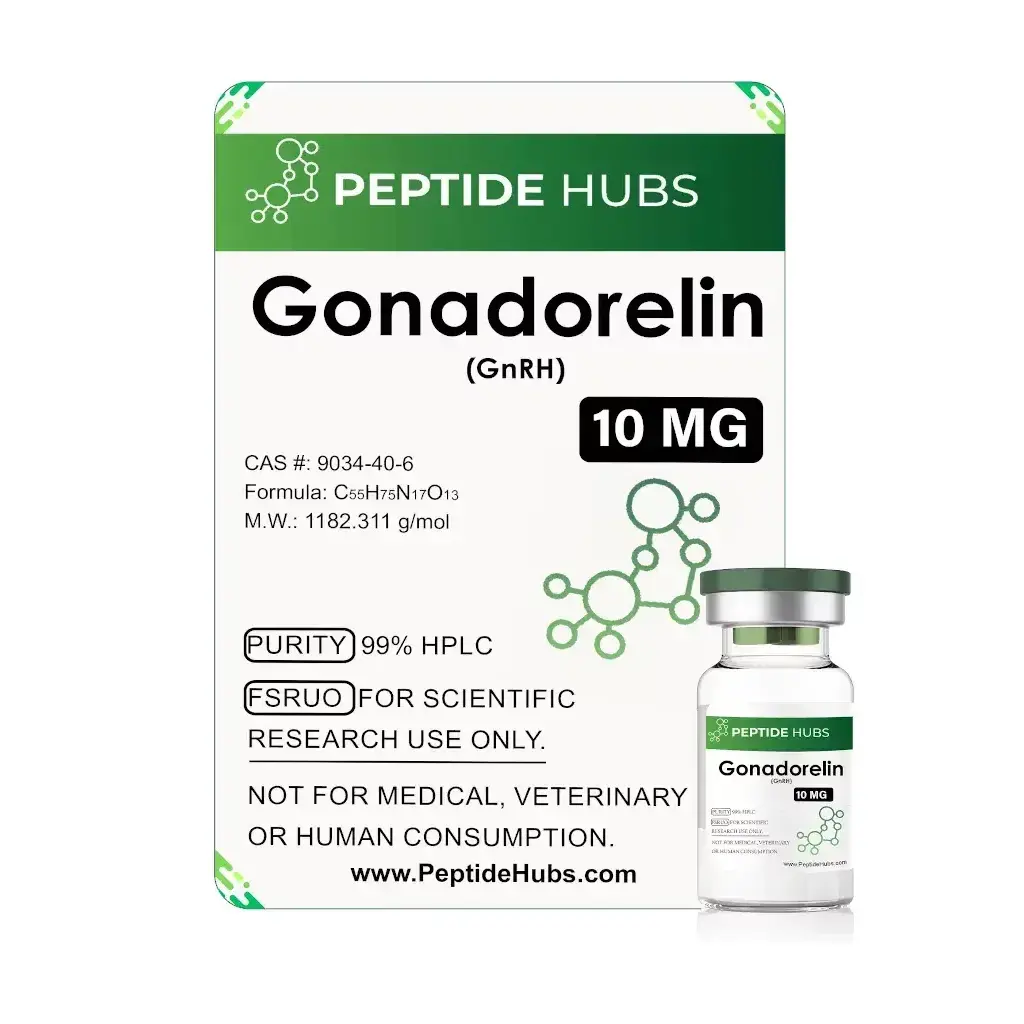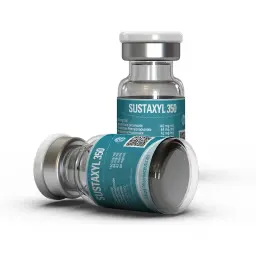


For Subcutaneous Injection
Composition: Gonadorelin (GnRH)
Dosage: 10 mg/vial
Unit: 2 mL Multidose Vial
Form: Lyophilized Powder
Manufactured by Peptide Hubs
Peptide Hubs Gonadorelin 10 mg is a lyophilized, research-grade preparation of gonadorelin (synthetic Gonadotropin-Releasing Hormone, GnRH) supplied in a sterile 2 mL vial for qualified laboratory use. Positioned at the apex of the hypothalamic–pituitary–gonadal (HPG) axis, GnRH provides a precise experimental handle for modeling LH/FSH signaling cascades, pulse dynamics, and downstream reproductive-endocrine markers in test systems. The 10 mg fill is selected by advanced buyers who need higher-concentration stock solutions, multi-arm study flexibility, and consistent aliquoting across longer protocols.
Important: The information on this page is for educational discussion within a lawful research context. This product is not a drug, food, or cosmetic and is not intended to diagnose, treat, cure, or prevent any disease. It is for use by qualified individuals or laboratories operating under applicable regulations and SOPs.
Gonadorelin is a decapeptide that binds GnRH receptors in the anterior pituitary to stimulate luteinizing hormone (LH) and follicle-stimulating hormone (FSH) release in experimental models. In labs that profile endocrine signaling, gonadorelin is used to map pulse timing, receptor responsiveness, and downstream effects along the HPG axis. For a foundational overview of GnRH biology within human endocrinology, see the NIH/NCBI endocrine references on hypothalamic–pituitary control here; this context helps frame pulse design, sampling windows, and endpoint selection.
The 10 mg vial supports concentrated stock solutions and extended study horizons. Many teams plan multi-arm comparisons (timing windows, pulse intervals, or washout durations) from a single batch to minimize lot-to-lot variability. Concentrated stocks can also reduce solvent volumes and handling frequency, improving day-to-day consistency. If you prefer smaller pilot batches, benchmark this presentation against lower-fill options (e.g., 5 mg formats) to align with your titration needs.
Because GnRH sits atop the HPG cascade, timing and pulse design are central to clean data. Establish a run-in baseline, then implement intervention phases with standardized administration clocks, sampling intervals, and nutrition guidelines. If your endpoints include LH/FSH proxies or sex-steroid surrogates, lock down confounders such as sleep, training status, and calorie/macronutrient intake. Predefine washout periods to separate acute from carryover effects, and log all deviations (missed timepoints, temperature excursions, reconstitution changes).
To isolate mechanisms, many teams run separate arms rather than stacking compounds. For instance, if you want to contrast systemic endocrine modulation with metabolic- or cosmetic-leaning pathways, design those as parallel programs with distinct hypotheses. This preserves interpretability and simplifies manuscript-ready reporting.
Timing: Fix administration times and sampling windows relative to meals, training, and sleep. Use the same operator checklists daily to reduce variance.
Confounders: Stabilize sleep duration/quality, caloric intake, macronutrient split, hydration, and training load. If endpoints include body-composition proxies, maintain a consistent scale routine and tape measurements.
Records: Document lot numbers, reconstitution solvent and volume, aliquot sizes, storage temperature, timestamps, and any deviations. These details are invaluable when interpreting outliers, revisiting pilot data, or drafting methods sections.
Peptide Hubs emphasizes careful sourcing, batch uniformity, and protective packaging for reliable transit across the USA. Clear labels and presentation aid inventory control and SOP compliance. Our catalog facilitates parallel-arm planning across distinct mechanisms—ideal for keeping systemic HPG work separate from GH-pathway, metabolic, cosmetic, or CNS-adjacent explorations. When you need repeatable handling and discreet, fast delivery, Gonadorelin 10 mg is designed to fit rigorous lab workflows.
Advanced buyers who prioritize high-strength stocks, multi-arm flexibility, and longer timelines select the 10 mg vial. It minimizes reconstitution frequency and supports identical handling over many study days—key to reproducibility. Teams newer to GnRH work may conduct a small pilot first, then scale to 10 mg once timing, sampling, and confounder control are dialed in.
Regulatory Notice: Not for human consumption. For lawful laboratory research by qualified individuals only. Follow all applicable regulations and your internal SOPs.
Gonadorelin is a synthetic GnRH used to model HPG-axis function in test systems, including LH/FSH pulse behavior, receptor responsiveness, and downstream endocrine markers.
Store lyophilized vials cool, dry, and protected from light. Reconstitute with bacteriostatic water using sterile technique, refrigerate after reconstitution, and avoid freeze–thaw cycling.
The 10 mg fill supports concentrated stock solutions, fewer reconstitutions, and consistent aliquoting across longer protocols and multi-arm designs from a single batch.
For clean data, evaluate different mechanisms in separate arms. For example, compare HPG work with GH-pathway or metabolic programs in parallel rather than stacking in a single arm.
No. This is a research-grade peptide not intended to diagnose, treat, cure, or prevent any disease. Use is limited to lawful laboratory research by qualified individuals.
Please log in to write Gonadorelin 10 mg review.

For Intramuscular Injection
Composition:
- Testosterone Propionate 42 mg
- Testosterone Phenylropionate 84 mg
- Testosterone Isocaproate 84 mg
- Testosterone Decanoate 140 mg
Mixed Dosage: 350 mg/1 mL
Unit: 10 mL Multidose Vial
Manufactured by Kalpa Pharmaceuticals